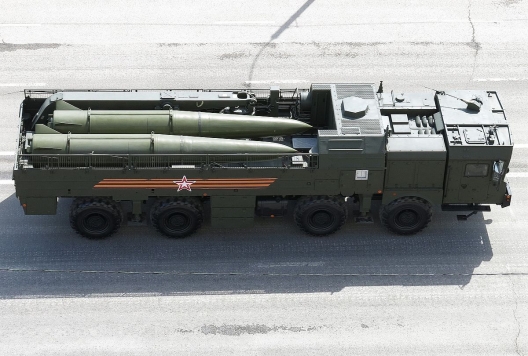 From Jonathan Marcus, BBC: Russia’s deployment of nuclear-capable missiles to its Kaliningrad exclave is setting off warning bells in the Baltics and at Nato.
From Jonathan Marcus, BBC: Russia’s deployment of nuclear-capable missiles to its Kaliningrad exclave is setting off warning bells in the Baltics and at Nato.
This is not the first time that the Russians have deployed Iskander-M short-range ballistic missiles to Kaliningrad and it will not be the last. Indeed, some experts believe Russia’s long-term plan is eventually to deploy the weapons permanently to the Russian enclave, sandwiched between Poland and Lithuania.
The Iskander-M system is relatively modern and was introduced into the Russian military in 2006. It is highly mobile – a pair of missiles are carried on a heavy-wheeled launcher. The missile is known as the SS-26 and code-named “Stone” by Nato. It is equipped with a variety of counter-measures to try to breach enemy defences. Fired from Kaliningrad, it can reach all of the Baltic republics and probably about two-thirds of Poland.
It is controversial on two counts – because of its range and because it is dual-capable. In other words, it can carry either a conventional or a nuclear warhead. Armed with a nuclear weapon, its range of in excess of some 500km (300 miles) brings it into the scope of the Intermediate Nuclear Forces (INF) treaty of 1987 which effectively bans the development and deployment of such weapons.
The US already believes that Russia has breached this treaty in its development work, but the regular deployment of the Iskander probably marks another nail in the coffin of the web of arms control agreements inherited from the Cold War.
Russia stresses that this deployment is part of a routine exercise. But equally, in the past it has brandished the Iskander system as a response to Nato’s plans to deploy anti-ballistic missile defences in Europe. Russia has made several threats to target countries deploying elements of any missile defence system with nuclear weapons. Indeed, Russia’s nuclear doctrine has also been re-written to afford a greater and earlier role for nuclear weapons in any regional conflict.
From Vanessa Gera, AP: Polish Defense Minister Antoni Macierewicz said Poland considers the matter of ‘‘highest concern’’ and is monitoring the situation.
The chief of staff of the Estonian Defense Forces, Lieutenant General Riho Terras told ERR that he sees the move as part of a larger Russian attempt to dominate the Baltic Sea.
‘‘In the long term, Russia’s wish is to bring the Baltic Sea and the passages leading to it more and more under its control, and to control it much like it does the Black Sea,’’ Terras said….
Russian Defense Ministry spokesman Major General Igor Konashenkov played down the concerns….
Konashenkov also said Russia used the deployment to figure out what range a US spy satellite has.
‘‘We exposed one Iskander before loading it on the Ambal [a cargo carrier] right under a US reconnaissance satellite flying above in order to verify the parameters of that space apparatus. We did not have to wait too long [for results],’’ he said, without elaborating.
From Reuters: “The deployment not only increases tensions in the region, but also possibly violates international treaties which limit deployment of ballistic missiles of range of over 500 kilometres,” Foreign Minister Linas Linkevicius told a news briefing in Vilnius….
Some modifications of the Iskander can hit targets 700 km (450 miles) away, putting the German capital Berlin in range of Kaliningrad, Linkevicius said.
Image: Transport loader for Iskander-M missile system, May 9, 2015 (photo: Boevaya mashina)

